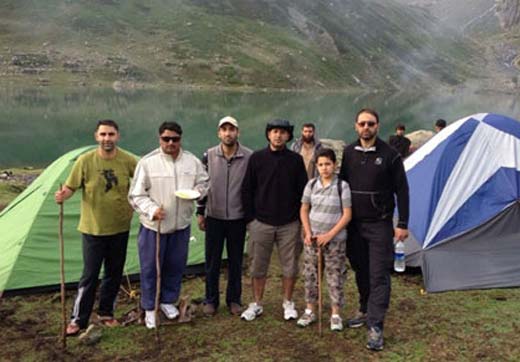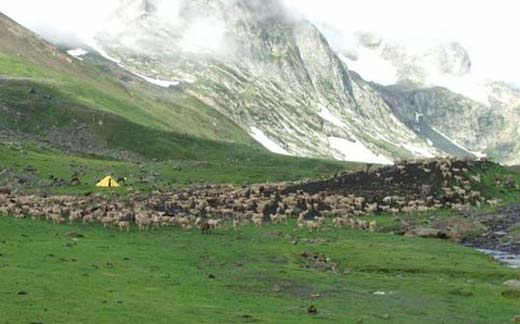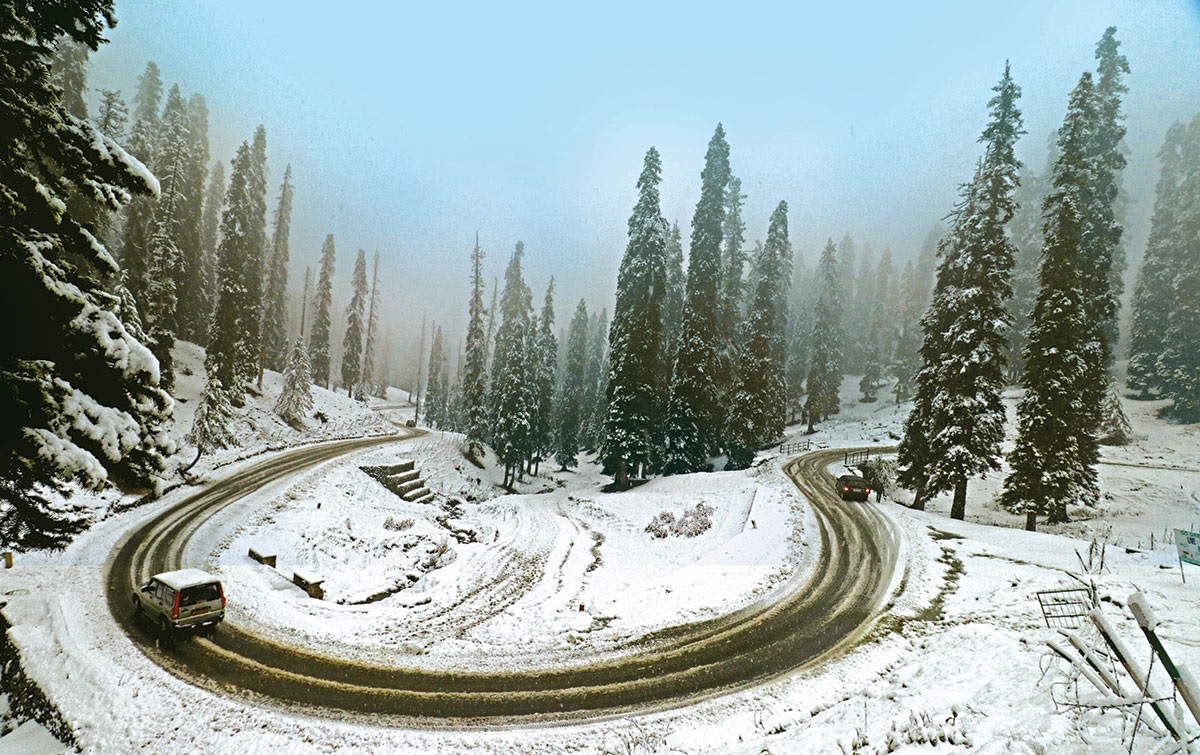Mufti Islah

Gangabal is stunning grassland perched at 15,000 feet spreads out mythically from the margins of two small almost-identical lakes, fed by the glacial melt of the Harmukh mountain ranges. The place is the latest obsession and madness for bold sight-seers. Obsession of being in the captivating green and sometimes barren brown hills, and madness, as the risk involved while going up a swirling feature can get real.
Last week seven of us, four guides who doubled up as decent cooks and five dwarf ponies went uphill to take in the scenes and scents of the place we so much are unawares of. Driving for slightly more than an hour from capital Srinagar, we reached Naranaag – a small hillside village which sits pretty over a bouncy wild stream and ruins of an ancient temple that still attracts a trickle of devotees. A double check at what we have – tents, clothing, food, maggie, jam, sauce, bread and other provisions – we were soon arching up through an uneven narrow pony-track in search of the first stopover – Butsheri, a mountain top which gives goose bumps to even expert hikers and local Gujjars acquainted with the steep ascent. After taking – God knows how many rests – on the edges of the track to avoid horse kicks and nudges and gulping down drops of water and fresh air, we curled up bit by bit through pine forests almost touching clouds. Muscles broken, back aching, heart in the mouth and prayers on lips, we went on like this for three hours until a Gujjar dhok cum dhaba stood in front of us. The smell of rotis, omelet’s, dangling chips and biscuits lit up our eyes.
Our tiresome, back-breaking journey was to come to an end though for a few minutes. We sipped tea, ate rotis and threw ourselves flat next to the fireplace for 20 minutes. Our next stop was Trinkund, a highpoint in the chain of the mountain ranges in upper Kangan and Sonamarg area.
=The rest at the tea-stall worked well for our tired bodies. The difficult part was seemingly over. We were now actually going up and down, crossing streams that gurgled under big round boulders, smooth pastures on which hundreds of sheep, mules and high-bred Zanskari horses feasted. We walked leisurely for around nearly 90 minutes till we caught the glimpse of a hut and an assortment of army tentages. Trinkund, the big pastureland which rises towards the tall mountains in almost every direction is a favourite site of foreign campers.
The fast flowing brooks, the breeze, the goat-herders in the facing hills add to its charm. Its scenery often forces trekkers to pitch their tents for the night-halt. But no, our group is determined to go on and settle near either of the Gangabal lakes.
Five hours of continuous trek can be exhausting and pull you down but the large swatches of greens almost touching the hazy blue sky can work as an elixir. As one moves ahead, the bulge in the accompanying stream can be felt easily. The number of sheep and the big shepherd dogs keep on growing till Harmukh, the highest of the mountains shows up.
The Harmukh is difficult and different. There is no record suggesting it has been scaled, perhaps because it is steep from all four sides and hence the name. The colour of its tissue varies from green to light brown to off-white.
In high summer, its peak is devoid of any snow but a glacier sits well inside the mountain belly, nature’s intervention for sure. Its glacial melt trickles into many streams before emptying into the twin lakes of Gangabal.
The roughly two km lake is where we decide to settle down. The bigger one on a higher ground is almost twice in size. The two striking freshwater lakes are not only easy on the eye but important reservoirs for game. They are anglers’ delight.
We pitch three tents near the smaller lake. It is six in the evening. The sun is playing hide and seek with the clouds and climbing down the Harmukh. A cool breeze greets us as the small fish pop up on the lake surface. Our cooks have a tough job to do. They have a steep deadline and have to prepare meat, chop onions and grind garlic.
Even in the trying conditions, they perform. The food is tasty but will digest only if there is good wild gossip? Our conversation veers around black and brown bears, leopards, mythical animals, rantus, dyans, (sorceresses) wanmohnev, (hairy jungle man) and waayyip (a goat with a woman head).
Next morning, the sunlight flickers through the tent top. Our men wash themselves up, sip tea and race towards the stream that flows out of the bigger Gangabal lake into the smaller one. A crafty angler as he is, Arshad Mattoo takes out his fishing rod from the hard plastic sheath. He likes the fish but the brown trout, found in abundance, is his first love. The trout is smart and a great survivor in the foamy stream waters and Arshad is no novice. He drops his line laced with a plastic wasp and a fly and taps gently near the boulders. Then with the extension of his arm, he throws the line again and again. He tugs once, twice, thrice, before hooking the trout. In less than three hours, his score is 19.
 Haider, the chief cook and his assistant Iftikhar, wink joyfully at each other on seeing the catch. The frying pan is literally blistering. Some spices thrown in on the fish and into the pan, the aroma wafts inside the tent. Thirty minutes later, we are crunching the crisp pieces of trout. Tasty. And then lo and behold, the rains and hail come down fast and furious. We slip into the tents for next three hours. At five, the sun starts to break through the pack of the clouds that rise above the Harmukh. A lone graylag goose circles around the lake examining carefully the ripples on the lake. It suspects fish, pecks furiously at the lake surface, then with great difficulty picks up its prized catch – a brown trout. The brown trout is agile unlike its lazy cousin – the rainbow trout. It hides under the round moss-covered boulders where the stream runs fast. It quite likes the shallow waters but can’t be waylaid easily.
Haider, the chief cook and his assistant Iftikhar, wink joyfully at each other on seeing the catch. The frying pan is literally blistering. Some spices thrown in on the fish and into the pan, the aroma wafts inside the tent. Thirty minutes later, we are crunching the crisp pieces of trout. Tasty. And then lo and behold, the rains and hail come down fast and furious. We slip into the tents for next three hours. At five, the sun starts to break through the pack of the clouds that rise above the Harmukh. A lone graylag goose circles around the lake examining carefully the ripples on the lake. It suspects fish, pecks furiously at the lake surface, then with great difficulty picks up its prized catch – a brown trout. The brown trout is agile unlike its lazy cousin – the rainbow trout. It hides under the round moss-covered boulders where the stream runs fast. It quite likes the shallow waters but can’t be waylaid easily.
For the evening stint, Arshad has the company of three Ms – Muheet, Maroof and Majid and 10 year old Abrar. This time they choose the out bouncy stream of the smaller lake. In next three hours till the light fades out and sun loses it second battle to clouds, they return. The score 16, 14 by Arshad.
The frying pan can be a proud possession in a place that is plucked off from civilization. We share a great meal and retire to our tents, pull out the sleeping bags, sleep and snore. Next morning we will walk back to where we began from.
The maggie and packaged pav bhaji can serve well if your mind clock sets targets. The Chinese have a great faith in noodles, possibly because it saves cooking time and digestion is slow. No need to waste time in placing wayside loos.
We begin at 7.30 on a fairly cool morning, and achieve our first target Trinkund in less than 90 minutes. We dare the mountains and keep treading the narrow pony tracks and rocky ways till we hit Nazir’s dhaba. We sip tea and eat rotis. The next target is stiff: to get down the steep Botsheri without losing life or limb although we certainly will pick up a few niggles or two. We keep on climbing down slowly and carefully for the next two hours till we get to see the Naranaag ruins and the violent stream quite below. At 12, we lie on our backs looking at the sky and the mountains. We are down but not out.















